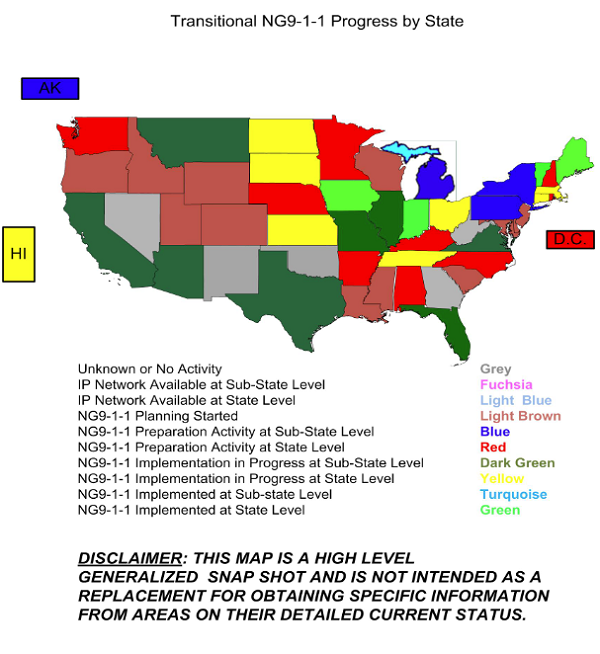We are all familiar with 911 and the simple yet significant value it has for our nation. Behind the scenes is a vast and complex infrastructure. With changes in technology, however, come necessary changes with this telecommunications infrastructure and legislation that pertains to it. Below are ten frequently asked questions to help you understand trends around 911, as well as information that all organizations must understand for compliance purposes.
E911: What Is It?
Not too long ago we all used POTS (Plain Old Telephone Service) and PRIs (Primary Rate Interface). Since the circuits were based on a physical address, almost all calls were originated from a reasonable physical distance from the phone system or demarc (yes, some got created with WATS and point-to-point circuits but those were the exceptions).
Today with VoIP and UC, someone could literally be anywhere when calling 911. This is a problem when you need to get emergency responders on site ASAP. So, the solution is to push geographic identifier information to the PSAP (Public Safety Answering Point) when calling from a MLTS (Multi-Line Telephone System), which will help emergency responders locate those in need of help. This could be address, floor, wing, or room information.
What About Cellular Callers?
According to NENA, as reported in The Wall Street Journal, 80% of 911 calls come from cellular devices. And not all communication to PSAPs are via phone calls anymore. This is why NG911 (Next Generation 911) was introduced -- to accommodate all forms of communication.
What Exactly Is NG911?
PSAPs are adapting to changing times by enabling themselves to be able to receive outreach via texts, video chat, social media, and VoIP. This will also allow the 911 call centers to transfer calls to other call centers and deal with call overload. However, many are not ready for this technology. It’s also very difficult to know if your local PSAP is capable of handling anything besides calls and SMS.
The Middle Class Tax Relief and Job Creation Act of 2012 authorized $112 million of new funding for a grant program to update PSAPs to NG911. As of February 2018, only 4 states are fully compliant, as shown in the below graphic.
What About Kari’s Law?
In February 2018, the original Telecommunications Act of 1934 and 1996 was further amended. In short, this change made it so that when someone dials out (regardless of POTS, SIP, VoIP, etc.) from a MLTS, dialing 911, they can always reach the PSAP without having to dial an additional number to get an outside line. In addition, on-site notifications must be issued as well, such as when 911 is dialed from a hotel property or office building, for example.
Do 911 Centers Need to Do Anything Different?
Yes, the PSAPs need to update their systems as well. Most will because the Middle Class Tax Relief and Job Creation Act of 2012 authorized $112 million to do this and prepare for NG911. But this does not mean all are compliant today.
Does This Affect Me?
It depends if you are in one of the 20 states that have passed applicable legislation or regulations. RedSky has a helpful website with legislation information regarding this topic.
Why Isn’t NG911 a Federal Law Like Kari’s Law?
In short, politics. Kari’s Law was an easy, bipartisan, amendment to the Federal Telecommunications Act. Reforming E911, although important, has much more ambiguity and regional influence in the specifics of regulation.
What Do We Have to Do?
If you are in one of the 20 states that have passed applicable legislation or regulations, you’ll need to make sure your equipment is compliant with the laws. Almost all phone equipment approximately seven years old (or newer) are compliant. However, you will need to make sure the phone system database is populated to send the appropriate information to the PSAP. For example, 734 Evergreen Terrace, Springfield, MA, 2nd floor, Northwest corner.
Is There Any Ongoing Maintenance Involved with This?
Yes, when you have MACDs (Move, Adds, Changes, Deletions), you will have to update this database with your telecom carrier. For example, if Michelle from the accounting department moves from the 2nd floor to the marketing department on the 5th floor, this extension will need to be updated. In addition, if you have connected buildings with one phone system, the street address will need to be updated when an employee moves between buildings.
What If We Don't Make These Changes?
You will be fined, or worse, face litigation because you are non-compliant. However, if your state has not implemented this law yet, you can request an extension.
Conclusion
VoIP and UC have radically changed telecommunications and we should incorporate standards for public safety. Unfortunately, these vary state by state, and it’s up to us to stay on top of the new laws coming into effect. Feel free to follow up with us if you need help!
"SCTC Perspectives" is written by members of the Society of Communications Technology Consultants, an international organization of independent information and communications technology professionals serving clients in all business sectors and government worldwide.











